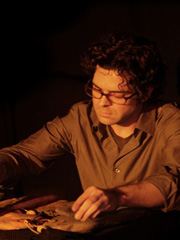People in the News
New Artist of the Month: Nathan Davis

ATLANTA -- At a concert in a grungy art space, Nathan Davis was playing with rocks, making eerily beautiful music. He’d found the long flat stones in a river in Vermont. Clapping them together or striking them with mallets -- backed by electronics that included babbling water and rustling autumn leaves -- he somehow created a vulnerable and poignant little world. The piece, called “Talking to Vasudeva,” encompasses key elements of Davis’ style: noise, electronics, a sense of shape and structure and unexpected emotion. His music often takes nature and the ambient world as a starting point.
“These things have been done before,” says the composer. “Thanks to John Cage, the idea of noise as music is mainstream. My generation has absorbed the electronics of Stockhausen and Alvin Lucier. Sounds that were weird a few decades ago are now commonplace. But I’m not experimenting. I don’t have to be dogmatic and austere. My pieces have straightforward harmonic progressions. The noise becomes part of the narrative.”
Based in New York’s Greenwich Village, Davis is a percussionist in the International Contemporary Ensemble (ICE). As a composer, his national reputation is just starting to blossom. Reviewing the opening of Lincoln Center’s Tully Scope Festival in February, New York Times critic Anthony Tommasini wrote about Davis’ “Bells,” performed by musicians from ICE and with audience participation via their cell phones: “The written-out parts of the piece provided a calming aural backdrop of chimes, slowly rising melodic lines in flutes and clarinets, penetrating low rumbles on the gongs, metallic flickers on small cymbals. From the collective cell phones came a wash of vibrating tones, Morse-code-like ticks, intoned spoken numbers, patches of crackling static, cosmic shimmers and more... all a part of an alluring and pensive musical experience.”
Davis, 38, studied at Rice and Yale universities, the son of an architecture professor at Auburn University in Alabama. “I was around architecture all the time,” he recalls, “where it wasn’t academic but experienced in real time, as the buildings were going up.” Fired by both the romance and logistics of the art form, he recounts the process, starting at his father’s drafting table and continuing seamlessly to the actual construction sites, where as a boy he’d walk along beams that would become the building’s skeleton.
The porch of his family’s house, designed by his father, also made an indelible impression. Its 360-degree view of the countryside, with woods and a lake, gave Davis “an architectural way of hearing space,” as he puts it, where “sounds would bounce off trees and were transmitted over the water in unique ways.” In his music today, “the sonic architecture is essential to the setting.”
Three weeks touring Bali as a soloist with *M.I.T.’s gamelan ensemble led by Evan Ziporyn, was another step toward enriching Davis’ musical palette. It gave him, he says, a structural framework. “Gamelan is sort of a non-Western thread running through my music,” he says, “including things like repetition of a long processional and an appreciation that there exists a continuum of music to noise.”
Anything can be contextualized, he reasons, and in pop music you hear anything and everything as a viable part of a song. In classical music, according to old-school thinking, “we’ve come to accept what a clarinet is supposed to sound like. To achieve that sound, you have to iron out all the sonic inconsistencies. But that [sound] is just one facet of the instrument.”
In some of his recent works, such as “Like Sweet Bells Jangled,” drawn from a line of Ophelia’s in “Hamlet” -- “Like sweet bells jangled, out of tune and harsh” -- he explores organic sounds made by the instruments. “I use extended technique a lot,” he says, “but in a natural way.”
That, he says, comes from life as a percussionist. “We’re obsessive tappers, always hitting things to see what you can get from it, where sound isn’t dependent on pitch or harmony. I love odd and unsustainable sounds.” Sometimes Davis uses a microphone like a stethoscope, if only for his own ears. In “Diving Bell,” he holds a microphone up to a triangle to catch overtones that the performer hears but that are lost by the time the sound reaches the audience.
Davis’ new recording, “The Bright and Hollow Sky” (available from his website, nathandavis.com, and iTunes) includes “Like Sweet Bells Jangled,” which is part of a series of works referring to bells and other forms of communication, such as cell phones, over long distances.
Although Davis started composing in high school, it’s safe to call him a rather late bloomer. Evan Ziporyn, the Bang on a Can clarinetist, M.I.T. professor and self-described post-minimalist composer, has known Davis for more than a decade, first as a percussionist. “Nathan’s got a real technical panache and a highly developed creativity as a percussionist,” he says. “But even as I was giving him important pieces to play, he was quiet as a composer. When he finally started showing me his own work, I was very impressed with the detail and the communication in his style. I’ve become a big fan of his music. I think what’s coming will be amazing.” *The Massachusetts Institute of Technology

WHO'S BLOGGING

Law and Disorder by GG Arts Law
Career Advice by Legendary Manager Edna Landau
An American in Paris by Frank Cadenhead





 FEATURED JOBS
FEATURED JOBS

 RENT A PHOTO
RENT A PHOTO


